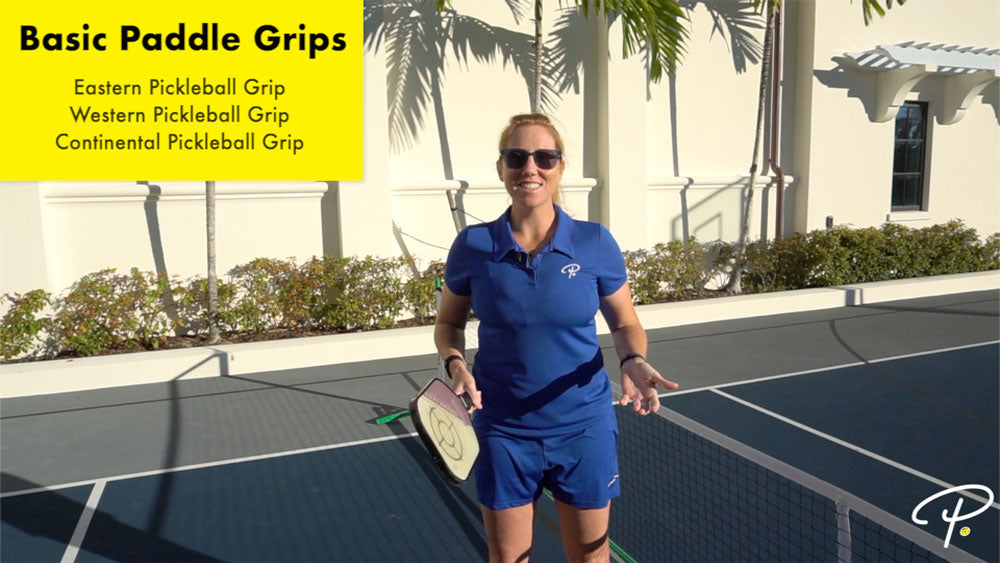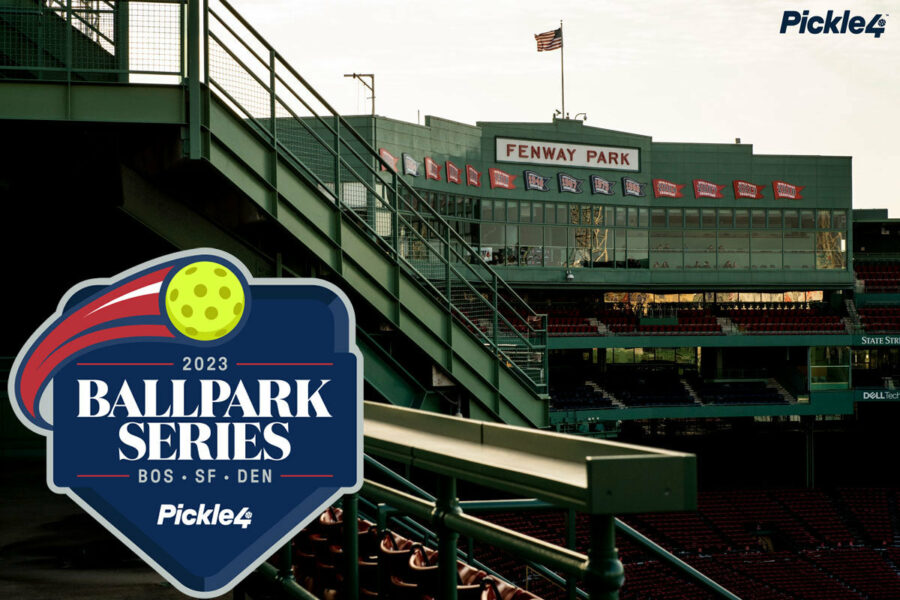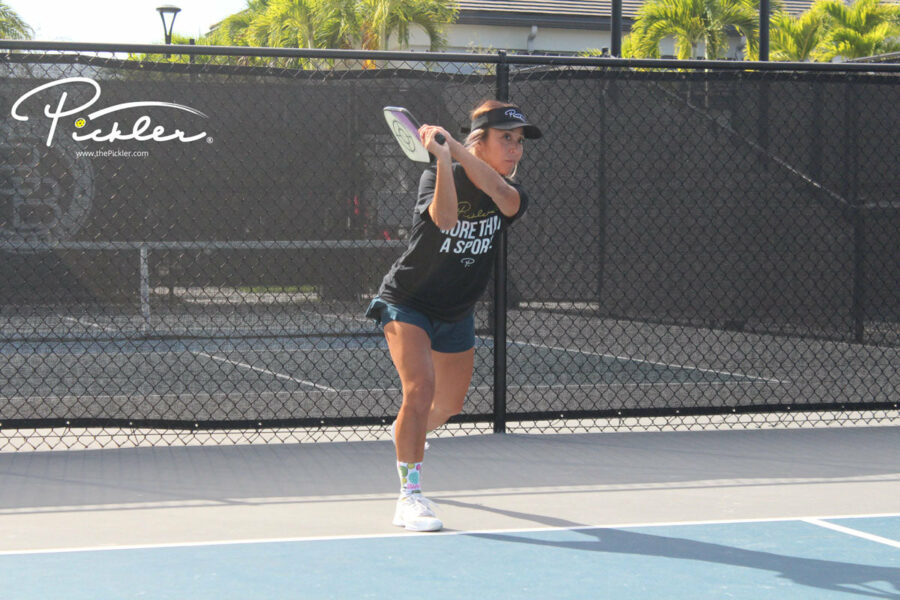Your pickleball grip – in other words, how you hold your pickleball paddle – is an important part of your pickleball play. Your pickleball grip will affect how you hit the pickleball and what kind of shots you hit on the pickleball court. As a result, it is important to use a pickleball grip that complements your style of play and accentuates your preferred shots on the pickleball court.
After reading this blog, you will understand:
- Which pickleball grip best suits your pickleball game;
- How to take advantage of weaknesses in your opponents’ pickleball grips;
- How to make pickleball grip changes;
- How much pickleball grip pressure you should have;
- How to test for your perfect pickleball grip size;
- How to replace a pickleball grip; and
- How to add a pickleball overgrip.
Pickleball Paddle Grips – How to Hold the Pickleball Paddle
There are three basic pickleball paddle grips in pickleball:
- Eastern Pickleball Grip
- Western Pickleball Grip
- Continental Pickleball Grip
It is important to understand each of these types of pickleball grips, including the pros and cons of each, as these pickleball grips will give important insights into where the pickleball will go and how you are able to reset for the next shot. These pickleball grips will also give you insights into your opponents’ style of play in order for you to take advantage of weaknesses in your opponents’ pickleball grips.
Eastern Pickleball Grip – Best Pickleball Paddle Grip for Beginners
The Eastern pickleball grip is the most popular paddle grip in pickleball. Generally, all beginner and intermediate players should use the basic Eastern pickleball grip on the pickleball courts. This is because the basic Eastern pickleball grip is universal or neutral, as this pickleball grip allows you to hit both a forehand and backhand shot with the same grip. In other words, the Eastern pickleball grip is the perfect compromise between a forehand pickleball shot and a backhand pickleball shot.
To find this Eastern pickleball grip, hold your pickleball paddle directly out in front of you with your opposite hand, such that the paddle face is looking evenly to the left of your body and to the right of your body. Take your hand that you are holding the pickleball paddle with and place it on the face of the pickleball paddle.
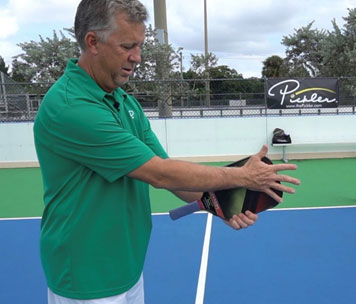
Slide your hand down the paddle face and shake hands with the pickleball paddle grip.
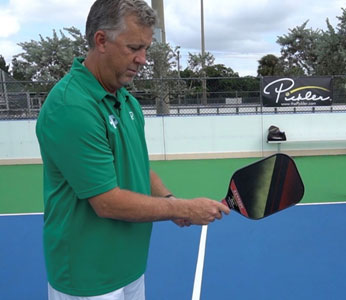
Western Pickleball Grip – Favors Forehands on the Pickleball Court
To find the Western pickleball grip, start in an Eastern grip and turn your wrist 90 degrees clockwise for righties, or 90 degrees counterclockwise for lefties. The Western pickleball grip produces a lot of top spin, but makes it very difficult to hit backhand shots on the pickleball court.
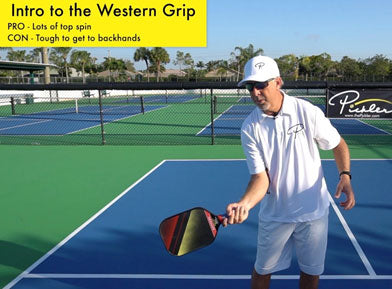
A Western pickleball grip causes your palm to generally be behind the pickleball paddle on a forehand, which results in powerful pickleball forehands. However, a Western pickleball grip causes your palm to generally be in front of the pickleball paddle on a backhand, which means that you will have little to no power on your backhand shots. Oftentimes, players using the Western pickleball grip will hit a backwards forehand shot on the backhand side because of this. So, if you face a player with a Western pickleball grip, try targeting his or her backhand side. However, be aware, as some players using the Western pickleball grip will use a two-handed backhand, which will help them compensate for a weak backhand shot.
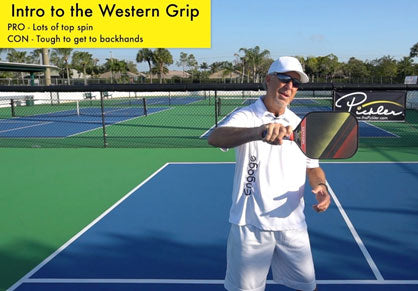
Continental Pickleball Grip – Favors Backhands on the Pickleball Court
The Continental pickleball grip is also called a hammer grip. This is because, to find the Continental pickleball grip, you will hold the pickleball paddle like you would a hammer when hitting a nail. In other words, to find the Continental pickleball grip, start in an Eastern grip and turn your wrist slightly counterclockwise for righties, or slightly clockwise for lefties, so that the V-shape between your thumb and your index finger is slightly to toward your non-paddle side.
The Continental pickleball grip is the complete opposite of the Western pickleball grip. The Continental pickleball grip produces nice dinks and backhands, but makes it more difficult to hit forehand shots on the pickleball court, as the Continental pickleball grip slightly favors backhands.
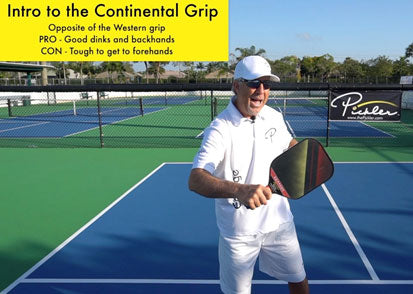
A Continental pickleball grip causes your palm to generally be behind the pickleball paddle on a backhand, which results in powerful pickleball backhands. However, a Continental pickleball grip causes your palm to generally be on the side/in front of the pickleball paddle on a forehand, which means that you may struggle to get your pickleball paddle in a position to squarely hit a forehand shot. As a result, if you face a player with a Continental pickleball grip, target his or her forehand-side shoulder and try to get them in an uncomfortable chicken wing, as he or she will have trouble flipping the pickleball paddle to hit a forehand.
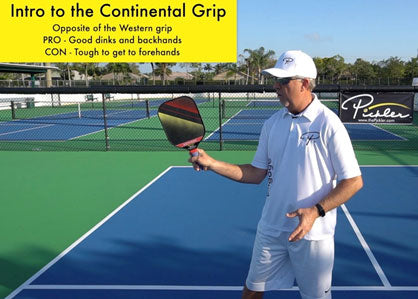
How to Hold Your Pickleball Paddle – Which Pickleball Grip Is Right for You
Pickleball grips are like habits—easy to get into and hard to change—and how you hold your pickleball paddle will certainly affect your pickleball play. If you have an odd pickleball grip, trying to change your pickleball grip later on can be difficult and frustrating. So, if you are beginner, start your pickleball game with good habits and the proper pickleball grip.
As mentioned above, it is important to use a pickleball grip that complements your style of play. If you have been playing for a while, and you have a pickleball grip that works for you, keep it. However, if your pickleball grip is not complementing your style of play, or if you are a beginner, consider using the Eastern pickleball grip.
Also, as noted above, most pickleball players – especially beginners – should use the Eastern pickleball grip because it is universal or neutral on both your backhand and forehand shots. In other words, the Eastern pickleball grip is the perfect compromise between a forehand pickleball shot and a backhand pickleball shot.
If it is more comfortable for you, consider giving a small turn toward the Continental pickleball grip (in other words, a slight mix of the Eastern and Continental pickleball grips), given that so much of the game in pickleball will be played at the pickleball net and consist mostly of dinks and fast volleys with little reaction time. In other words, most shots in pickleball will play into the benefits of a Continental pickleball grip—nice dinks and backhands.
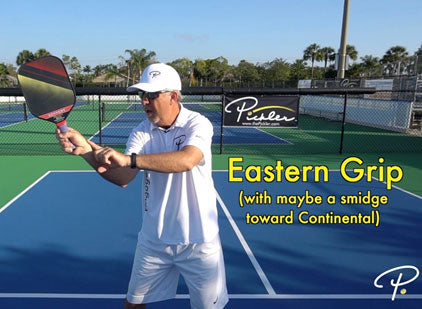
Should You Put a Finger Up on Your Pickleball Grip?
You may notice that some pickleball players put a finger or two, or even a thumb, up onto the face of the pickleball paddle. This is common from pickleball players with a table tennis (also sometimes referred to as ping pong) background. Placing a finger, fingers, or thumb on the pickleball paddle face may give you more control of the pickleball paddle. However, the downside is that your fingers and/or thumb are then exposed to being hit by the pickleball, which could result in some mishits on the pickleball court.
Two-Handed Backhand Pickleball Grip
To hit a two-handed backhand on the pickleball court, start with your preferred pickleball grip. Then, place your non-paddle hand on the paddle grip on top of your paddle hand, so that your palm of your non-paddle hand is behind the paddle handle when you hit the pickleball. Consider putting your index finger of your non-paddle hand on the face of the back of the pickleball paddle. As noted above, this will help give you more control of the pickleball paddle on your backhand shots (without the downside of having your index finger exposed to being hit by the pickleball, as your index finger will be on the backside of the pickleball paddle).
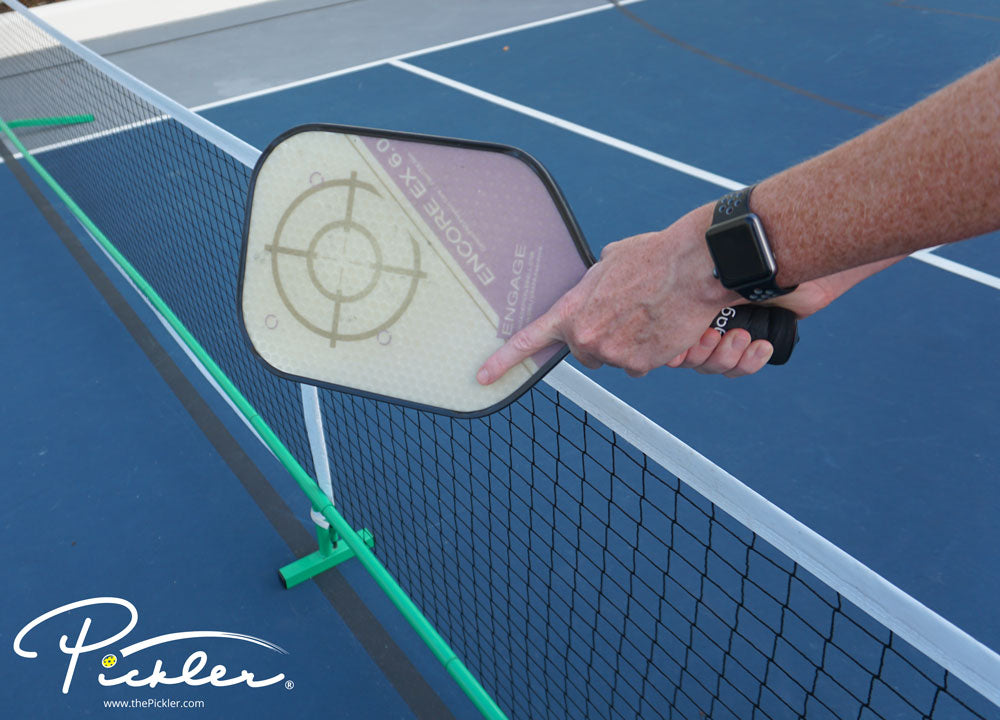
Pickleball Grip Changes – When and How to Change Your Pickleball Grip
Generally speaking, the sport of pickleball does not provide much time to change your pickleball grip between shots. This is one key difference between pickleball and tennis, as, in tennis, players have significantly more time to change their racquet grip. In pickleball, since so much of the game is played at the Non-Volley Zone (or Kitchen) line, there can be fractions of a second between shots, which is certainly not enough time to change your pickleball grip.
Given the lack of time between shots, it is more important in pickleball to stick to one pickleball grip on the court (for instance, the Eastern pickleball grip (maybe with a smidge toward the Continental pickleball grip)). However, there may be opportunities for small pickleball grip changes. For instance:
- when you are playing at or near the baseline on the pickleball court (for instance, serves, returns of serve, and third shots – whether a drop or a drive); and
- at the higher skill levels, pickleball players are making small grip changes during points and between shots.
To make small pickleball grip changes, lightly place the fingertips of your non-paddle hand on the outside edge of the pickleball paddle. Use your fingertips to torque your pickleball paddle when you have time to manipulate your pickleball grip between shots. Make sure that you keep your grip strength on the weaker side, so that you can easily manipulate the pickleball paddle in your hand. If you hold the pickleball paddle too tight, you will not be able to quickly torque your paddle with the fingertips of your non-paddle hand. However, when you strike the pickleball, remember that this non-paddle hand will let go of the pickleball paddle.
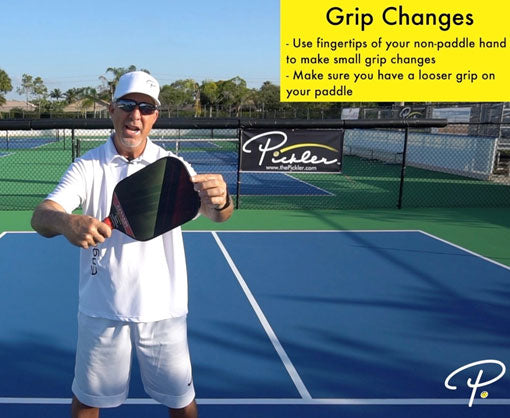
Try some small pickleball grip changes to alter the direction of the pickleball. For instance, consider a small pickleball grip change to a Western pickleball grip on a forehand drive from the baseline, or a small pickleball grip change to a Continental pickleball grip on a backhand drive from the baseline. However, make sure that you quickly revert to the neutral Eastern pickleball grip (maybe with a smidge toward the Continental pickleball grip) to get ready and prepare for the next shot!
Pickleball Grip Pressure – The Importance of Loose, Relaxed Grip Pressure
Many pickleball players grip their pickleball paddles way too tightly and in the palm of their hand – think a 10 out of 10 pickleball grip pressure, where the pickleball player is “white knuckling” the pickleball paddle. Too much pickleball grip pressure, and too much palm on the pickleball paddle, are negatives on the pickleball courts because too much pickleball grip pressure and/or too much palm on the pickleball paddle will likely result in loss of control of the pickleball and loss of feel of the pickleball off of the paddle. In other words, too much pickleball grip pressure on the paddle, and/or too much palm on the pickleball paddle, will likely cause the pickleball to ricochet and rebound off of the paddle too aggressively and too high (and, high balls generally mean easy put away shots for your opponents).
As a result, it is important to have a loose, relaxed pickleball grip on the pickleball court – think a 4 out of 10 pickleball grip pressure. It is also important to hold the pickleball paddle more in your fingers and less in the palm of your hand. If you loosen your pickleball grip pressure and use more of your fingers to hold the pickleball paddle, you will have a softer touch with your pickleball paddle, and vice versa. A loose, relaxed pickleball grip will help you reset fastballs on the pickleball court, as well as give you more control of your shots (such as your dinks and drop shots).
Pickleball Grip Size – What Pickleball Grip Size Is Best for You?
The rules of pickleball do not regulate the thickness of a pickleball paddle. This includes the pickleball paddle grip size – a pickleball paddle grip can be as thin or thick as desired. With that said, most pickleball paddle grips are between 4 inches and 4.5 inches in circumference. The pickleball grip size that you prefer comes down to your preference (including your preference on the weight, bulk, and comfort of the pickleball grip).
If you are unsure on your preferred pickleball grip size, there are a few tests that you can do to determine what is the best pickleball grip size for you. Determining the best pickleball grip size for you can also be helpful in getting rid of tennis elbow, as the wrong pickleball grip size may be a factor to tennis elbow pain.
Height Test for Pickleball Grip Size
The best pickleball grip size could depend on your height.
|
Your Height |
Suggested Pickleball Grip Size |
|
Below 5’ 3” |
4” circumference |
|
5’ 3” to 5’ 8” |
4.25” circumference |
|
Above 5’ 8” |
4.5” circumference |
Finger Length Test for Pickleball Grip Size
The best pickleball grip size could be the length from the tip of your paddle-hand ring finger to the middle crease of your paddle-hand palm. Whatever the resulting measurement is – between the tip of your paddle-hand ring finger to the middle crease of your paddle-hand palm – is the best pickleball grip size for you. To note, if you are in between two sizes, consider choosing the smaller pickleball grip size.
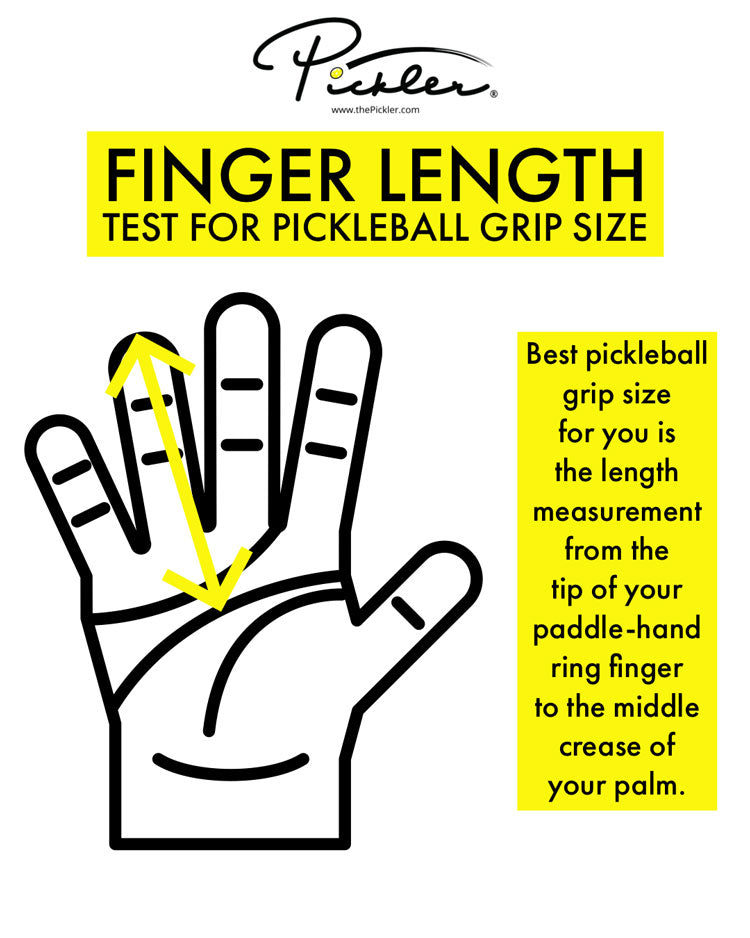
Index Finger Test for Pickleball Grip Size
The last method to test what pickleball grip size is correct for you requires a pickleball paddle. Grab the pickleball paddle using the Eastern pickleball paddle grip. As a reminder, to find this Eastern pickleball grip, hold your pickleball paddle directly out in front of you with your opposite hand, such that the paddle face is looking evenly to the left of your body and to the right of your body. Take your hand that you are holding the pickleball paddle with and place it on the face of the pickleball paddle.

Slide your hand down the paddle face and shake hands with the pickleball paddle grip.

Now, place the index finger of your free hand in the gap between your finger tips and thumb of your hand holding the pickleball paddle. If your index finger fits snug in the gap, then you likely have the best pickleball grip size for you. If your index finger cannot fit in the space, then the pickleball grip size may be too small. If your index finder fits in the space with plenty of room on either side, then the pickleball grip may be too large.
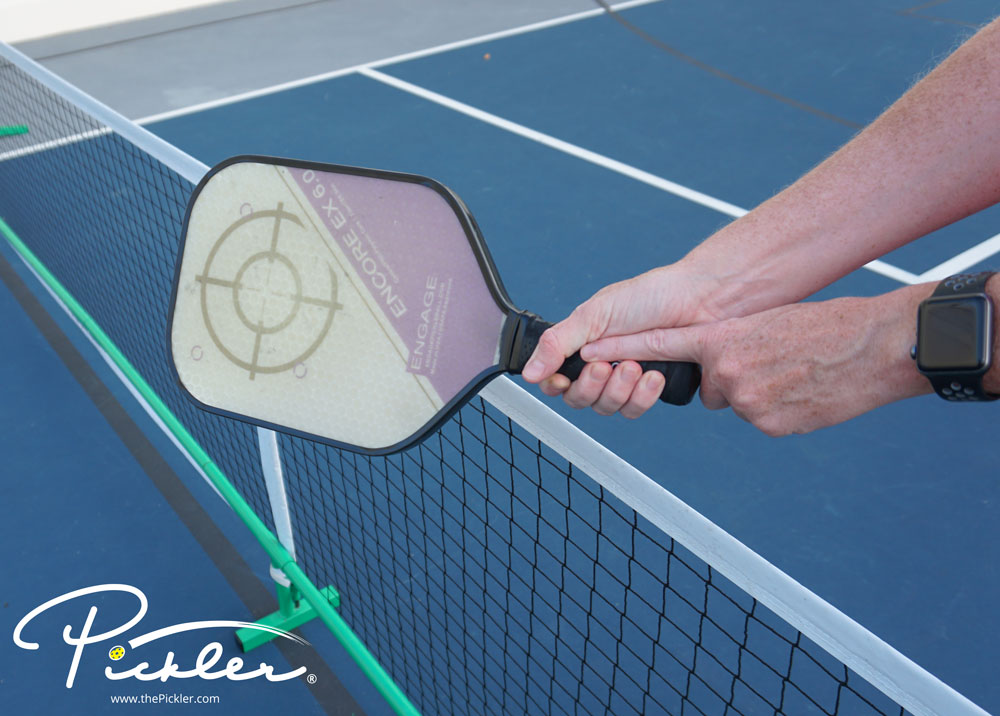
Please note, however, that this index finger test for grip size is more common in tennis, as tennis generally features larger grip sizes for larger racquets. As a result, this test may not produce the most accurate results for pickleball grip size. We suggest using this index finger test in conjunction with the height test and finger length test for pickleball grip size.
When in Doubt as to Pickleball Grip Size…
When you have doubts as to what pickleball grip size is best for you, it is, generally speaking, better to go with the smaller pickleball grip size. This is because a small pickleball grip size will provide for more wrist action on your shots, which may lead to more power on your shots, as well as more spin and control of the pickleball. Further, if your pickleball grip size is too big, your pickleball paddle may slip in your hand.
Lastly, if you decide that you are not happy with your pickleball grip size, you can always change it. You can do this by re-gripping your pickleball paddle or adding additional pickleball grips or overgrips. More on this below!
Pickleball Grips and Pickleball Overgrips
A pickleball grip is the leather-like wrap on the handle of the pickleball paddle. A pickleball grip has a sticky backing and quite a bit of cushioning to cover the wood or composite material that makes up the pickleball handle. This provides for a more comfortable feel in your hand.
A pickleball overgrip is a thinner, spongey wrap that goes on top of your pickleball grip. Pickleball overgrips generally provide a tacky surface to grip the pickleball paddle with, as well as better sweat absorption and additional comfort.
Both pickleball grips and pickleball overgrips can get worn out and need to be replaced over time, especially if you are playing pickleball regularly. To note, pickleball overgrips are generally less expensive than pickleball grips. So, oftentimes, pickleball players will use an overgrip to avoid having to replace their pickleball grips quite so often.
To grab pickleball grips and overgrips for your pickleball paddle, visit Fromuth Pickleball and use the code 10PICKLER for 10% off (to note, some exclusions apply; court equipment, Babolat, and Selkirk-branded merchandise and paddles are excluded)!
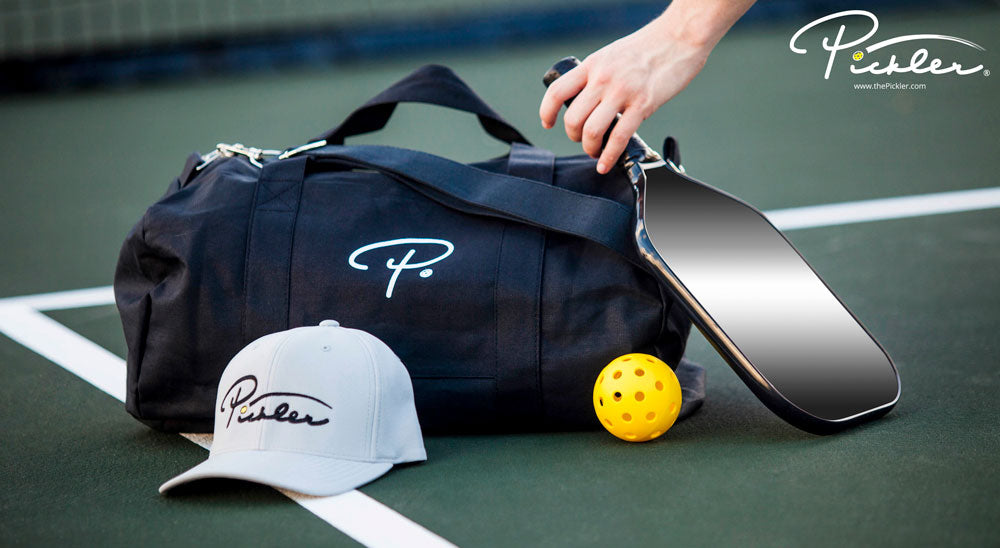
How to Replace a Pickleball Grip
To replace your pickleball grip:
- Take off your old pickleball grip by removing the tape at the top of your pickleball handle and unwrapping the old pickleball grip until it is entirely separate from your pickleball paddle.
- Take the angled piece of the new pickleball grip and align with the bottom of your pickleball paddle near the butt cap of your pickleball paddle. The pickleball grip should be even with the bottom of your paddle handle and the pickleball grip should start to taper wider as you move up the paddle handle.
- Wrap the new pickleball grip around the pickleball paddle handle. As you wrap the pickleball grip around the paddle handle, be sure to pull the pickleball grip taut so that there are no wrinkles in the material. Consider adjusting your pickleball grip size when you replace your pickleball grip. To make your pickleball grip size smaller, wrap the new pickleball grip more loosely. To make your pickleball grip size larger, wrap the new pickleball grip more tightly, so that the pickleball grip has more overlap with each time around the paddle handle.
- Confirm that the new pickleball grip has an angle when you reach the top of the paddle handle. If not, you may need to cut the new pickleball grip so that it has an angle at the top (similar to the angle at the beginning of the new pickleball grip). The pickleball grip should be even with the top of the paddle handle and the pickleball grip should start to taper wider as your move down the paddle handle.
- Place a piece of thin finishing tape (for instance, electrical tape) over the top of the pickleball grip at the top of the paddle handle. Wrap the finishing tape on top of itself so that it seals the pickleball grip in place.
How to Add an Overgrip to a Pickleball Paddle
To add a pickleball overgrip:
- Take the new pickleball overgrip and align with the bottom of your pickleball paddle near the butt cap of your pickleball paddle. The pickleball overgrip should be even with the bottom of your paddle handle.
- Wrap the new pickleball overgrip around the pickleball paddle handle. As you wrap the pickleball overgrip around the paddle handle, be sure to pull the pickleball overgrip taut so that there are no wrinkles in the material. Consider adjusting your pickleball grip size when you replace your pickleball overgrip. To make your pickleball grip size smaller, wrap the new pickleball overgrip more loosely. To make your pickleball grip size larger, wrap the new pickleball overgrip more tightly, so that the pickleball overgrip has more overlap with each time around the paddle handle.
- Cut the new pickleball overgrip at an angle when you reach the top of the paddle handle. The pickleball overgrip should be even with the top of the paddle handle and the pickleball overgrip should start to taper wider as your move down the paddle handle.
- Place a piece of thin finishing tape (for instance, electrical tape) over the top of the pickleball overgrip at the top of the paddle handle. Wrap the finishing tape on top of itself so that it seals the pickleball overgrip in place.

